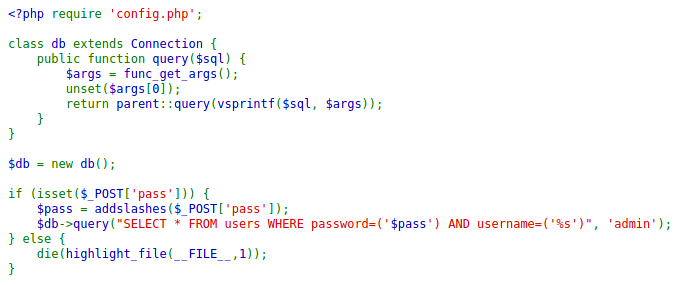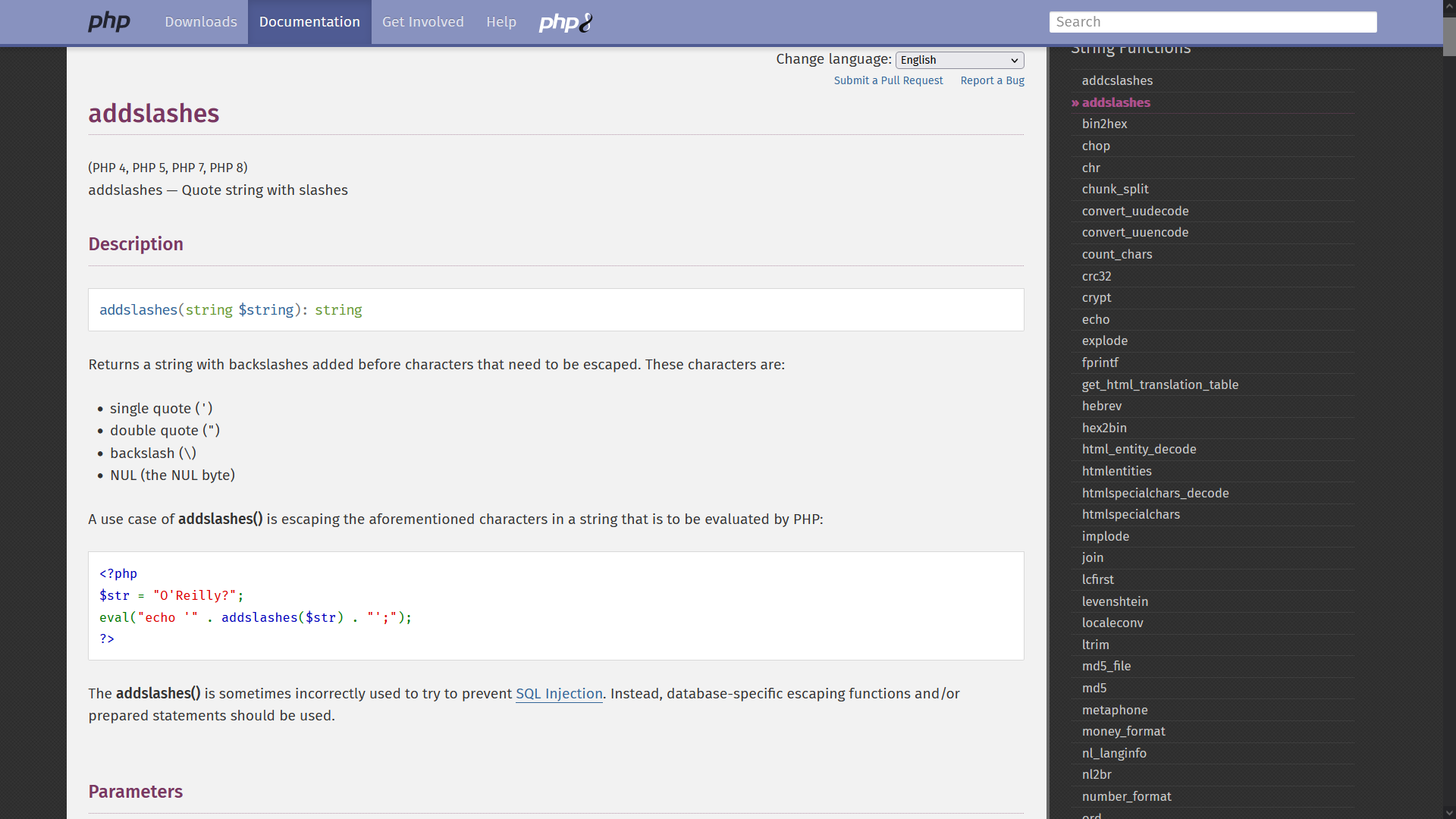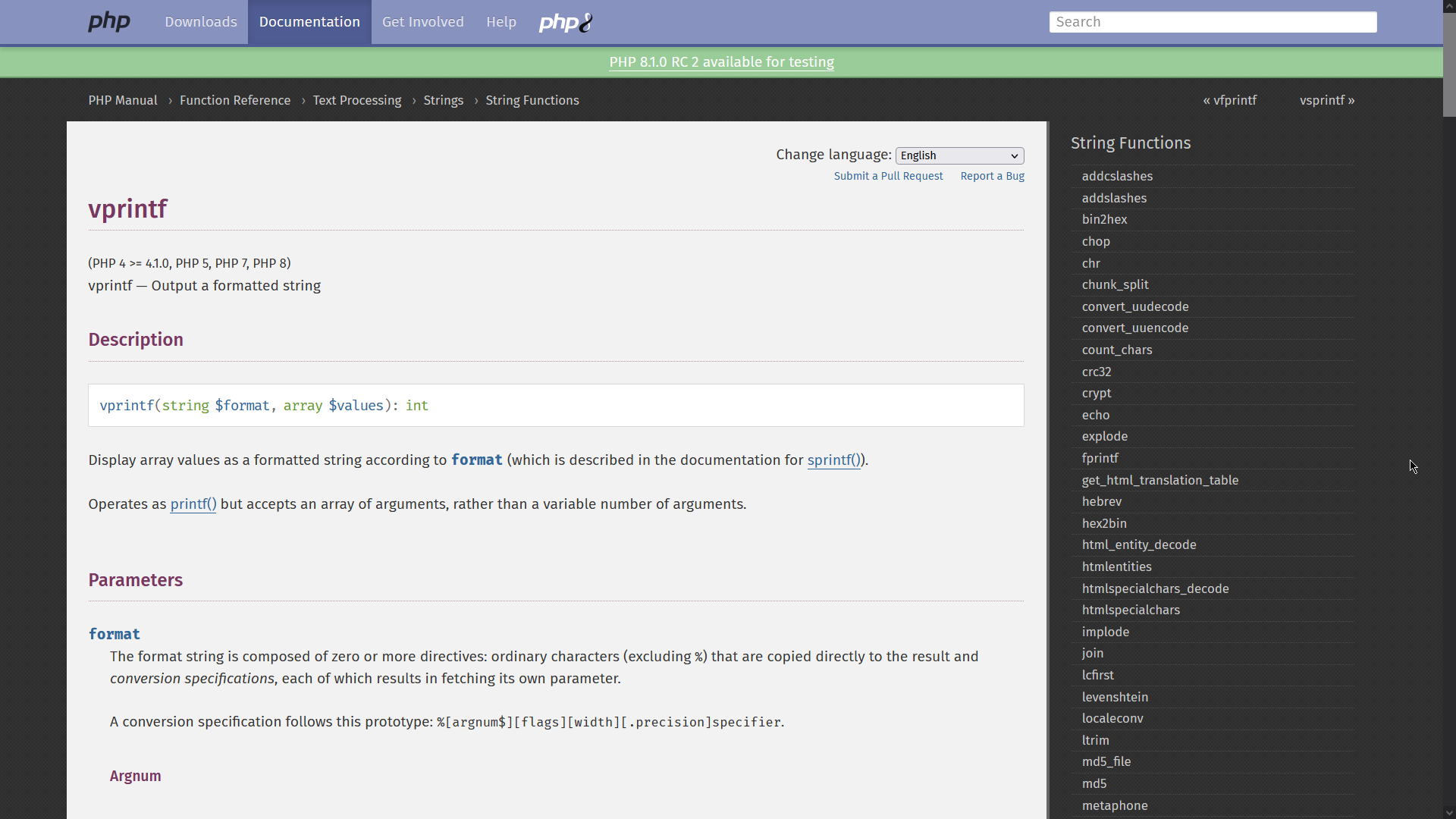28 Sep 2021 | Reading time: ~5 min
Bypassing addslashes() using format string to get SQL Injection
baby sql - HackTheBox
#HackTheBox #Challenge #Web #Medium #real_escape_string #addslashes #vsprintf #MySQL #SQL-injection

Table of contents
Introduction
Learn how to bypass the addslashes() function using format strings and get SQL Injection in this HackTheBox challange called baby sql.
Improved skills
- SQL Injection attacks
- Format string vulnerabilities exploitation (
vsprintf()) - Bypassing security functions (
addslashes())
Video
Writeup [TL;DR]
I heard that addslashes() functions protect you from malicious user input inside SQL statements. I hope you can’t prove me wrong…
Information Gathering
The challenge starts showing us just this simple PHP code that accepts a POST parameter, sanitizes it and then tries to perform a SQL query.
<?php require 'config.php';
class db extends Connection {
public function query($sql) {
$args = func_get_args();
unset($args[0]);
return parent::query(vsprintf($sql, $args));
}
}
$db = new db();
if (isset($_POST['pass'])) {
$pass = addslashes($_POST['pass']);
$db->query("SELECT * FROM users WHERE password=('$pass') AND username=('%s')", 'admin');
} else {
die(highlight_file(__FILE__,1));
}

This code looks secure, but is it really?
Let’s investigate the code better and try to understand what it does exactly.
- First, the code requires a config file whose content is unknown to us.
- Right after it defines a db class having a public function called
query. The function accepts an argument, it divides it into different elements contained within the$argsarray, it clears the first$argselement and finally returns the results of a query composed using thevsprintf()function. - Then it instantiates a
$dbobject and checks if thepassPOST parameter is set. If it’s not, it prints the current page, otherwise it takes the content of thepassparameter, sanitizes it and finally it calls thequeryfunction inserting the submitted input within the SQL query.
Ok, everything’s clear for now.
To better analyze the behaviour of the code, let’s create a local copy and add some debugging information.
<?php
class db {
public function query($sql) {
echo "query: " . $sql . "<br>\n";
$args = func_get_args();
echo "Args: " . $args[0] . "<br>\n";
unset($args[0]);
echo "Num Args: " . count($args) . "<br>\n";
echo "Args: " . $args[1] . "<br>\n";
return vsprintf($sql, $args);
}
}
$db = new db();
if (isset($_POST['pass'])) {
echo "Pass: " . $_POST['pass'] . "<br>\n";
$pass = addslashes($_POST['pass']);
echo "Pass after addslashes: " . $pass . "<br>\n";
$res = $db->query("SELECT * FROM users WHERE password=('$pass') AND username=('%s')", 'admin');
echo "Res: " . $res . "<br>\n";
} else {
die(highlight_file(__FILE__,1));
}
We can remove both the require instruction as well as the definition of the parent class Connection and the parent::query function because we are not interested in executing the actual query, we just want to analyze input behaviour.
For testing purposes we can fire up an easy and fast php server using the php -S IP:port command and then browsing to that specific IP and port to verify that the PHP page is correctly hosted.

Good, the page works correctly! Let’s see what happens when we send the pass parameter.

Makes sense, it is inserted within the query and used as a password. What happens if we insert a basic SQL injection payload instead?

Mmmm… Interesting. Quotes are escaped after having been processed by the addslashes() function.
As mentioned within the official PHP documentation:
addslashes returns a string with backslashes added before characters that need to be escaped. These characters are:
- single quote (
')- double quote (
")- backslash (
\)- NUL byte

We can verify it by passing those symbols within the pass parameter. 
In the current situation the limit imposed by the addslashes() function prevents us from escaping from the query and executing a sql injection, however there is still a function that is known to be vulnerable in other languages like C and C++ and that perhaps can help us break the restrictions.
vsprintfreturns a formatted string. It operates assprintf()but accepts an array of arguments. […] A conversion specification follows this prototype:%[argnum$][flags][width][.precision]specifier.

Format strings are special strings containing placeholders that will be substituted with future variables and that define in which format the variable will be processed and printed. They exist in almost every programming language: in python 1, in C 2, in PHP 3, and so on.
In our case for example %s is the placeholder that will be substituted with $arg.
The Bug
Looking carefully at the source code however it is possible to notice that we can control the format argument through the pass parameter because the symbols used to define conversion specification strings (% and $) are not sanitized by the addslashes() function (which considers only ' " and \).
Continuing to read the documentation it is possible to find a special flag that allows padding the result with arbitrary characters.

Since our input has already been sanitized when it is processed by the vsprintf() function, we can inject any arbitrary character and basically evade the query!

Exploitation
Ok, now we can carry out our sql injection attack against the real target without big problems. Let’s fire up Burpsuite and discover which kind of SQL Injection attacks we can perform.
Basic UNION queries seem useless because results are not shown within the server response.

Time-based attacks might work, the server replies after the desired time so it may be possible to enumerate db data using timing.

However the fastest technique is to execute arbitrary queries and exfiltrate the results using error messages since the server replies with verbose errors.

Oh, we also already got the name of the DB currently in use, cool!
First let’s extract all the tables from the database. Let’s use the extractvalue() and concat() to execute the query and extract its results within the errors.

Subquery returns more than 1 row
That’s right, when using error-based SQL injection results must be returned in one single row, while the query we have performed returns a row for every table found. Let’s fix this by grouping and concatenating all the results within a single one.

Shish, there are too many tables and the output is cut off. Let’s try to introduce a WHERE statement to filter out undesired results. Because we don’t want to deal with other quotes or double-quotes, we can use the hexadecimal representation to specify filters. In this way we can extract only the tables contained within the desired database.

Nice, totally_not_a_flag sounds very interesting, let’s enumerate its columns in the same way as before.

Mmmm… A single column named Flag: it sounds even more interesting this time.
Let’s see what’s contained inside this table:

This time addslashes() doesn’t protect you from malicious user input I guess.